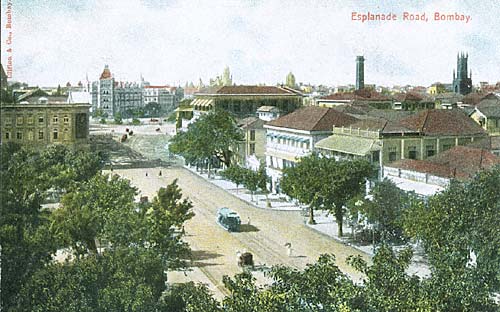
Figure 1. The Esplanade, Bombay 1857.
Please click on this image and later ones for larger images.

Bombay - The Esplanade and Colaba in the distance. March 1870 (from the top of Watson's Hotel).--Artist: Lester, John Frederick (1825-1915)-Date: 1871

Please click on this image and later ones for larger images.

Bombay - The Esplanade and Colaba in the distance. March 1870 (from the top of Watson's Hotel).--Artist: Lester, John Frederick (1825-1915)-Date: 1871

Marine Battalion, Esplanade.
Lithograph of the Marine Battalion at the Esplanade by Jose M. Gonsalves (fl. 1826-c.1842). Plate 4 from his 'Lithographic Views of Bombay' published in Bombay in 1826. Gonsalves, thought to be of Goan origin, was one of the first artists to practice lithography in Bombay and specialised in topographical views of the city. In 1772, the English feared an attack on Bombay by the French and cleared a semi-circular area of land around the fort to provide a clear line of fire. This area was known as the Esplanade. In the southern section of this area, there was a parade ground known as Marine Lines. This view shows a battalion soldiers on parade with military bungalows in the background

MAY BE EAST INDIA COMPANY TROOPS IN TENT
Photos of Bombay in 1857
Lithograph of the Marine Battalion at the Esplanade by Jose M. Gonsalves (fl. 1826-c.1842). Plate 4 from his 'Lithographic Views of Bombay' published in Bombay in 1826. Gonsalves, thought to be of Goan origin, was one of the first artists to practice lithography in Bombay and specialised in topographical views of the city. In 1772, the English feared an attack on Bombay by the French and cleared a semi-circular area of land around the fort to provide a clear line of fire. This area was known as the Esplanade. In the southern section of this area, there was a parade ground known as Marine Lines. This view shows a battalion soldiers on parade with military bungalows in the background

Friday, May 9, 2014
Photos of Bombay in 1857
........................................................................................
later views of Bombay esplanade

Esplanade Road, Bombay
Clifton & Co., Bombay, ~ 1905![]()
DESCRIPTION
ABOUT VINTAGE PHOTOGRAPHY
Whence Realism ............ Period Photography in India.
Photography first made its inroads into India as early as the 1840`s. With this technology , representational accuracy could be ascertained for the first time. The, then British Government in India laid great emphasis on this development , as a method of documentation and precise determination .Landscapes , Archeological sites , Durbars , Princes , Ethnic Tribes and all came under the lens , photographed , documented and preserved for posterity. Not only the Colonial Masters , but Princes and common people became amateur and professional photographers . It was the " great innovation "of the 19th century. It`s effects touched Fine Art , Empire Building , humanities and cultural understanding . Distances started coming closer and realism came to be the order.
Samuel Bourne, Macfarlane , Edmund David Lyon , William Henry Pigou became the new pioneers of Indian Photography .Even Indian Princes such as Ram Singh of Jaipur became Amateur Photographers , while the Nizam and Udaipur had their own private photography studios . Raja Deen Dayal , became a Legend in Indian Photography , starting with his studios in Secundrabad and Indore. Taking the challenge photography placed in front of fine artists , they took to colouring portraits and landscape photographs blending the traditional with the modern.
With the coming of Digital Photography , the traditional forms have been phased out and they have moved to the realm of Art and collectible s. Major Museums all over the world are now collecting period photography.
Photography first made its inroads into India as early as the 1840`s. With this technology , representational accuracy could be ascertained for the first time. The, then British Government in India laid great emphasis on this development , as a method of documentation and precise determination .Landscapes , Archeological sites , Durbars , Princes , Ethnic Tribes and all came under the lens , photographed , documented and preserved for posterity. Not only the Colonial Masters , but Princes and common people became amateur and professional photographers . It was the " great innovation "of the 19th century. It`s effects touched Fine Art , Empire Building , humanities and cultural understanding . Distances started coming closer and realism came to be the order.
Samuel Bourne, Macfarlane , Edmund David Lyon , William Henry Pigou became the new pioneers of Indian Photography .Even Indian Princes such as Ram Singh of Jaipur became Amateur Photographers , while the Nizam and Udaipur had their own private photography studios . Raja Deen Dayal , became a Legend in Indian Photography , starting with his studios in Secundrabad and Indore. Taking the challenge photography placed in front of fine artists , they took to colouring portraits and landscape photographs blending the traditional with the modern.
With the coming of Digital Photography , the traditional forms have been phased out and they have moved to the realm of Art and collectible s. Major Museums all over the world are now collecting period photography.
MAY BE EAST INDIA COMPANY TROOPS IN TENT
Esplanade and Bandstand, Bombay
below photo view:- "from tents towards Malabar hill ,across esplanade
watson hotel under construction
Bombay Esplanade LATER with watson hotel [Esplanade hotel]
Interiors: Esplanade House (1887) Waudby Road, Fort.

No comments:
Post a Comment